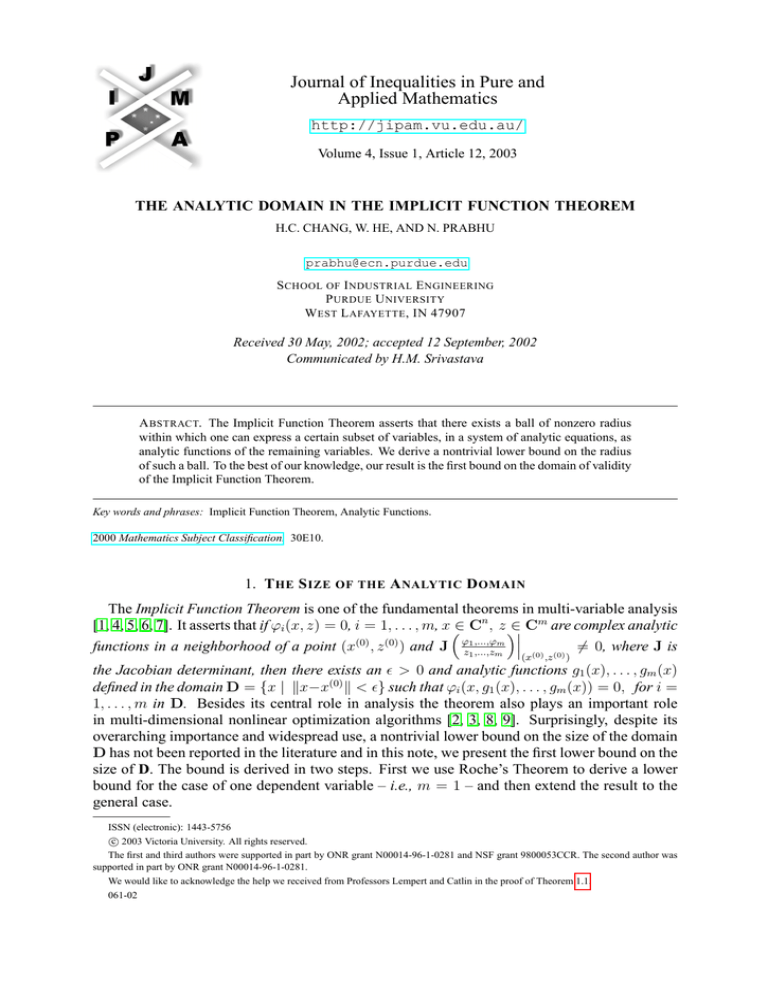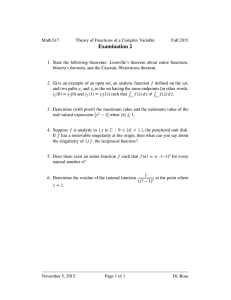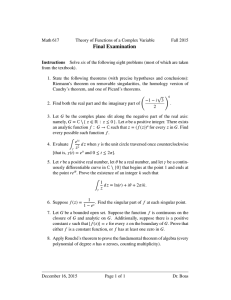
Journal of Inequalities in Pure and
Applied Mathematics
http://jipam.vu.edu.au/
Volume 4, Issue 1, Article 12, 2003
THE ANALYTIC DOMAIN IN THE IMPLICIT FUNCTION THEOREM
H.C. CHANG, W. HE, AND N. PRABHU
prabhu@ecn.purdue.edu
S CHOOL OF I NDUSTRIAL E NGINEERING
P URDUE U NIVERSITY
W EST L AFAYETTE , IN 47907
Received 30 May, 2002; accepted 12 September, 2002
Communicated by H.M. Srivastava
A BSTRACT. The Implicit Function Theorem asserts that there exists a ball of nonzero radius
within which one can express a certain subset of variables, in a system of analytic equations, as
analytic functions of the remaining variables. We derive a nontrivial lower bound on the radius
of such a ball. To the best of our knowledge, our result is the first bound on the domain of validity
of the Implicit Function Theorem.
Key words and phrases: Implicit Function Theorem, Analytic Functions.
2000 Mathematics Subject Classification. 30E10.
1. T HE S IZE OF THE A NALYTIC D OMAIN
The Implicit Function Theorem is one of the fundamental theorems in multi-variable analysis
[1, 4, 5, 6, 7]. It asserts that if ϕi (x, z) = 0, i = 1, . . . , m, x ∈ Cn , z ∈ Cm are complex analytic
m functions in a neighborhood of a point (x(0) , z (0) ) and J ϕz11 ,...,ϕ
6= 0, where J is
,...,zm (0) (0)
(x
,z
)
the Jacobian determinant, then there exists an > 0 and analytic functions g1 (x), . . . , gm (x)
defined in the domain D = {x | kx−x(0) k < } such that ϕi (x, g1 (x), . . . , gm (x)) = 0, for i =
1, . . . , m in D. Besides its central role in analysis the theorem also plays an important role
in multi-dimensional nonlinear optimization algorithms [2, 3, 8, 9]. Surprisingly, despite its
overarching importance and widespread use, a nontrivial lower bound on the size of the domain
D has not been reported in the literature and in this note, we present the first lower bound on the
size of D. The bound is derived in two steps. First we use Roche’s Theorem to derive a lower
bound for the case of one dependent variable – i.e., m = 1 – and then extend the result to the
general case.
ISSN (electronic): 1443-5756
c 2003 Victoria University. All rights reserved.
The first and third authors were supported in part by ONR grant N00014-96-1-0281 and NSF grant 9800053CCR. The second author was
supported in part by ONR grant N00014-96-1-0281.
We would like to acknowledge the help we received from Professors Lempert and Catlin in the proof of Theorem 1.1.
061-02
2
H.C. C HANG , W. H E , AND N. P RABHU
Theorem 1.1. Let ϕ(x, z) be an analytic function of n + 1 complex variables, x ∈ Cn , z ∈ C
at (0, 0). Let ∂ϕ(0,0)
= a 6= 0, and let |ϕ(0, z)| ≤ M on B where B = {(x, z)| k(x, z)k ≤ R}.
∂z
Then z = g(x) is an analytic function of x in the ball
2
1
M r2
kxk ≤ Θ1 (M, a, R; ϕ) :=
|a| r − 2
,
where r = min R2 , |a|R
.
2M
M
R − rR
Proof. Since ϕ(x, z) is an analytic function of complex variables, by the Implicit Function
Theorem z = g(x) is an analytic function in a neighborhood U of (0, 0). To find the domain
of analyticity of g we first find a number r > 0 such that ϕ(0, z) has (0,0) as its unique zero
in the disc {(0, z) : |z| ≤ r}. Then we will find a number s > 0 so that ϕ(x, z) has a unique
zero (x, g(x)) in the disc {(x, z) : |z| ≤ r} for |x| ≤ s with the help of Roche’s theorem. Then
we show that in the domain {x :k x k≤ s} the implicit function z = g(x) is well defined and
analytic.
Note that if we expand the Taylor series of the function ϕ with respect to the variable z, we
get
∞ ∂ j ϕ(0,0) j
X
z
∂ϕ(0, 0)
∂z j
ϕ(0, z) =
z+
.
∂z
j!
j=2
Let us assume that | ∂ϕ(0,0)
| = a > 0. |ϕ(0, z)| ≤ M on B where B = {(x, z) :k (x, z) k≤ R} .
∂z
Then by Cauchy’s estimate, we have
j
∂ ϕ(0,0) z j |z|j
∂zj
≤ j M.
j!
R
This implies that
|ϕ(0, z)| ≥ |a| · |z| −
∞
X
M
j=2
= |a| · |z| −
(1.1)
|z|
R
j
M |z|2
.
R2 − |z|R
Since our goal is to have |ϕ(0, z)| > 0, it is sufficient to have |a| · |z| −
both sides by |z| we get
|a| >
M |z|2
R2 −|z|R
> 0. Dividing
M |z|
⇐⇒ |a|(R2 − |z|R) − M |z| > 0 ⇐⇒ |z|(|a|R + M ) < |a|R2
− |z|R
|a|R2
R
⇐⇒ |z| <
=
.
M
|a|R + M
1 + |a|R
R2
We next choose
r = min
= min
R
,
1+1
R
M
M
+ |a|R
|a|R
R |a|R2
, 2M
2
.
To compute s we need Roche’s Theorem.
Theorem 1.2 (Roche’s Theorem). [1] Let h1 and h2 be analytic on the open set U ⊂ C, with
neither h1 nor h2 identically 0 on any component of U . Let γ be a closed path in U such that
the winding number n(γ, z) = 0, ∀z ∈
/ U . Suppose that
|h1 (z) − h2 (z)| < |h2 (z)|,
J. Inequal. Pure and Appl. Math., 4(1) Art. 12, 2003
∀z ∈ γ.
http://jipam.vu.edu.au/
T HE A NALYTIC D OMAIN IN THE I MPLICIT F UNCTION T HEOREM
3
Then n(h1 ◦ γ, 0) = n(h1 ◦ γ, 0). Thus h1 and h2 have the same number of zeros inside γ,
counting multiplicity and index.
Let h1 (z) := ϕ(0, z), and h2 := ϕ(x, z). We can treat x as a parameter, so our goal is to find
s > 0 such that if |x| < s, then
|ϕ(0, z) − ϕ(x, z)| < |ϕ(0, z)|,
∀z ∈ γ,
where γ = {z : |z| = r}. We know |ϕ(0, z) − ϕ(x, z)| < M s if γ ⊂ B and we also have
|z|2
|ϕ(0, z)| > |a| · |z| − RM
2 −|z|R from (1.1). It is sufficient to have
M s < |a| · |z| −
M |z|2
.
R2 − |z|R
On γ, we know |z| = r, and therefore as long as
1
M r2
s<
|a|r − 2
,
M
R − rR
we can apply the Roche’s theorem and guarantee that the function ϕ(x, z) has a unique zero,
call it g(x). That is, ϕ(x, g(x)) = 0 and g(x) is hence a well defined function of x.
Note that in Roche’s theorem, the number of zeros includes the multiplicity and index. Therefore all the zeros we get are simple zeros since (0, 0) is a simple zero for ϕ(0, z). This is because
ϕ(0, 0) = 0 and ϕz (0, 0) 6= 0. Hence we can conclude that for any x such that |x| < s, we can
find a unique g(x) so that ϕ(x, g(x)) = 0 and ϕz (x, g(x)) 6= 0.
We use Theorem 1.1 to derive a lower bound for m ≥ 1 below. Let ϕi (x, z) = 0, i =
1, . . . , m, x ∈ Cn , z ∈ Cm be analytic functions at (x(0) , z (0) ). Let
∂ϕ1 (x(0) ,z(0) )
∂ϕ1 (x(0) ,z (0) ) ···
∂z1
∂zm
.
.
(0) (0)
= am 6= 0
..
..
(1.2)
Jm (x , z ) := ∂ϕm (x(0) ,z(0) )
∂ϕm (x(0) ,z (0) ) ···
∂z
∂z
m
1
and let
(1.3)
ϕi (x(0) , z1 , . . . , zm ) ≤ M, for i = 1, . . . , m
on
(1.4)
B = {(x, z1 , . . . , zm ) | k(x, z) − (x(0) , z (0) )k ≤ R}.
Since Jm (x(0) , z (0) ) 6= 0, some (m − 1) × (m − 1) sub-determinant in the matrix corresponding
to Jm (x(0) , z (0) ) must be nonzero. Without loss of generality, we may assume that
∂ϕ2 (x(0) ,z(0) )
∂ϕ2 (x(0) ,z (0) ) ···
∂z2
∂zm
.
.
(0) (0)
..
..
(1.5)
Jm−1 (x , z ) := ∂ϕm (x(0) ,z(0) )
∂ϕm (x(0) ,z (0) ) ···
∂z
∂z
2
m
= am−1 6= 0.
By induction we conclude that there exist analytic functions ψ2 (x, z1 ), . . . , ψm (x, z1 ) and that
(0)
we can compute a Θm−1 (x(0) , z1 ; ϕ2 , . . . , ϕm ) > 0 such that
ϕi (x, z1 , ψ2 (x, z1 ), . . . , ψm (x, z1 )) = 0,
i = 2, . . . , m
in
(0)
(0)
Dn+1 := {(x, z1 ) | k(x, z1 ) − (x(0) , z1 )k ≤ Θm−1 (x(0) , z1 ; ϕ2 , . . . , ϕm )}.
J. Inequal. Pure and Appl. Math., 4(1) Art. 12, 2003
http://jipam.vu.edu.au/
4
H.C. C HANG , W. H E , AND N. P RABHU
Define
(1.6)
Γ(x, z1 ) := ϕ1 (x, z1 , ψ2 (x, z1 ), . . . , ψm (x, z1 )).
Then we have
m
∂Γ
∂ϕ1 X ∂ϕ1 ∂ψi
=
+
·
.
∂z1
∂z1
∂z
∂z
i
1
i=2
(1.7)
Since ϕ2 (x, z1 , ψ2 , . . . , ψm ) = 0, . . . , ϕm (x, z1 , ψ2 , . . . , ψm ) = 0 in Dn+1 , differentiating with
respect to z1 we have
m
∂ϕi
∂ϕi X ∂ϕi ∂ψj
=
+
·
= 0; i = 2, . . . , m
∂z1
∂z1 j=2 ∂zj ∂z1
or in other words
(1.8)
∂ϕ2
∂z2
···
..
.
∂ϕm
∂z2
∂ϕ2
∂zm
..
.
···
∂ϕm
∂zm
∂ψ2
∂z1
..
.
∂ψm
∂z1
= −
∂ϕ2
∂z1
..
.
∂ϕm
∂z1
.
Using Cramer’s rule and (1.8) we have
∂ϕ2
∂ϕ2
∂ϕ2
∂ϕ2
∂ϕ2 ∂z2 · · · ∂zi−1 ∂z1 ∂zi+1 · · · ∂zm ..
..
..
..
.. .
.
.
.
. ∂ϕm
∂ϕ
∂ϕ
∂ϕ
∂ϕ
m
m
m
· · · ∂zi−1 ∂z1 ∂zi+1 · · · ∂zmm ∂ψi
∂z2
(1.9)
=−
; i = 2, . . . , m.
∂z1
Jm−1
Substituting (1.9) into (1.7) and simplifying we get
∂ϕ1 (x(0) ,z(0) )
∂ϕ1 (x(0) ,z (0) ) ···
∂z1
∂zm
.
.
..
..
(0)
(0)
(0)
(0)
∂ϕ
(x
,z
)
∂ϕ
(x
,z
)
m
m
(0)
···
∂Γ(x(0) , z1 )
∂z1
∂zm
=
∂z1
Jm−1 (x(0) , z (0) )
Jm (x(0) , z (0) )
am
=
=
6= 0.
Jm−1 (x(0) , z (0) )
am−1
Therefore we can apply Theorem 1.1 to Γ(x, z1 ) and conclude that there exists an implicit
function z1 = g1 (x) in
Dn := x ∈ Cn kx − x(0) k
am
(0) (0)
≤ Θ1 M,
, min R, Θm−1 (x , z1 ; ϕ2 , . . . , ϕm ) ; ϕ1
am−1
such that in Dn , ϕi (x, g1 (x), g2 (x), . . . , gm (x)) = 0, i = 1, . . . , m where gj (x) := ψj (x, g1 (x)),
j = 2, . . . , m.
In summary, the sought lower bound on the size of the analytic domain of implicit functions
is expressed recursively as
(1.10) Θm (x(0) , z (0) ; ϕ1 , . . . , ϕm )
= Θ1
J. Inequal. Pure and Appl. Math., 4(1) Art. 12, 2003
am
(0)
M,
, min(R, Θm−1 (x(0) , z1 ; ϕ2 , . . . , ϕm )); ϕ1
am−1
http://jipam.vu.edu.au/
T HE A NALYTIC D OMAIN IN THE I MPLICIT F UNCTION T HEOREM
5
using the definition of Θ1 in Theorem 1.1 and of M, am , am−1 and R in equations (1.3), (1.2),
(1.5) and (1.4) respectively.
R EFERENCES
[1] R.B. ASH, Complex Variables, Academic Press, 1971.
[2] D.P. BERTSEKAS, Nonlinear Programming, Athena Scientific Press, 1999.
[3] R. FLETCHER, Practical Methods of Optimization, John Wiley and Sons, 2000.
[4] R.C. GUNNING, Introduction to Holomorphic Functions of Several Variables: Function Theory, CRC Press, 1990.
[5] L. HORMANDER, Introduction to Complex Analysis in Several Variables, Elsevier Science
Ltd., 1973.
[6] S.G. KRANTZ, Function Theory of Several Complex Variables, Wiley-Interscience, 1982.
[7] R. NARASIMHAN, Several Complex Variables, University of Chicago Press, 1974.
[8] S. NASH AND A. SOFER, Linear and Nonlinear Programming, McGraw-Hill, 1995.
[9] J. NOCEDAL AND S.J. WRIGHT, Numerical Optimization, Springer Verlag, 1999.
J. Inequal. Pure and Appl. Math., 4(1) Art. 12, 2003
http://jipam.vu.edu.au/





